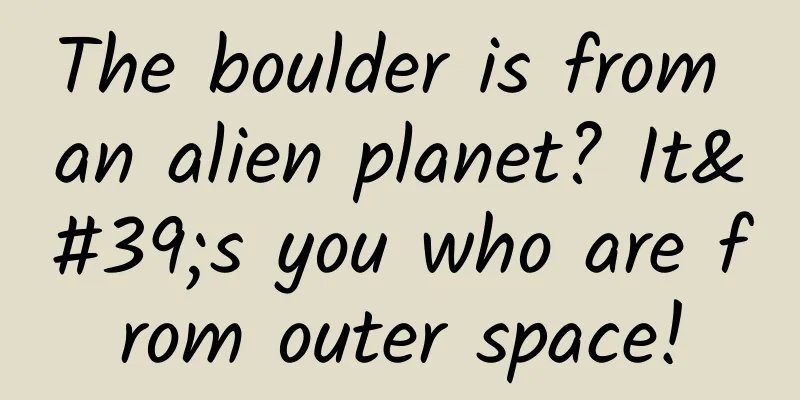The boulder is from an alien planet? It's you who are from outer space!

|
Author: Ji Yang The article comes from the Science Academy official account (ID: kexuedayuan) —— A piece of stone can actually cause global madness. First, the United States, Britain, Romania, then Russia, Spain, Australia... Several pieces of "star" stones of unknown origin, which appeared and disappeared from time to time, visited many countries one after another. For a time, many people speculated that this was a masterpiece of aliens. Mysterious metal monolith (Image source: CATERS NEWS) We still cannot say for sure whether these mysterious rocks are from aliens, but the fact is that the rocks may not be from aliens, but humans are definitely from aliens. Why does it sound even more unreliable? So let's put aliens aside and talk about the rocks. The history of stone is very long. For example, a small piece of stone can be associated with the four great classics: Dream of Red Mansions is also known as The Story of the Stone; the Monkey King in Journey to the West jumped out of a stone; General Hong in Water Margin knocked down the stone tablet of the "Palace of Subduing Demons", causing 108 "demon kings" to appear; the imperial seal picked up by Sun Jian in Romance of the Three Kingdoms was of course also a stone. Not to mention the story of Nuwa using five-colored stones to mend the sky, the "Classic of Mountains and Seas" which records strange stones, as well as the Egyptian pyramids, the British Stonehenge, the stone statues on Easter Island, etc. Stonehenge, England (Photo credit: veer) But today, what I want to talk to you about is not the historical story of stone, but the compounds that make up stone. Stones are generally composed of calcium carbonate (CaCO₃) and silicon dioxide (SiO₂), which include four elements: calcium, carbon, oxygen, and silicon. The scientific proof that the above stones come from extraterrestrial planets must start with the "magician" of nature - elements. Element: A magician with a myriad of transformations What are elements? An atom is the smallest particle that cannot be divided in a chemical reaction. The smallest unit of matter composed of atoms is called an element. An element is a general term for a class of atoms with the same nuclear charge number (number of protons). Periodic table of elements (Image source: Chinese Chemical Society) Elements are the building blocks of everything in the world. According to the periodic table published in 2018, there are currently 118 elements in total, 94 of which are natural elements (the natural element with the largest atomic number is plutonium). These 118 elements are the "magicians" that create the world. Because individual elements are very lively, they like to "flirt" with each other in a flash to produce new compounds, so the elements have ever-changing arrangements and combinations. This is also how everything you see, hear, and think about is formed - including yourself. With elements, you, your dog, and your dog's job exist. You and your dog are both carbon-based organisms. Calcium makes up your teeth and bones. You breathe the same oxygen. In addition, your body also has the same hydrogen, nitrogen, phosphorus, sulfur, potassium... And dogs, like you, also need to regularly supplement trace elements to enhance nutrition. Elements are the real masters of this world. They determine our past, present and future like magicians. Although there is still controversy over whether humans originated from land or sea, at least we can be sure that we "came" from the elements - the question is: where did the elements on earth come from? What is on earth is also in heaven All chemical elements on Earth can be found in the universe. Last December, Chang'e 5 collected 2 kg of soil samples from the moon, and people eagerly opened the "express delivery". As for what was in the "express delivery", you don't need to ask to know: the moon is rich in helium (He), of which the 3He storage in the lunar surface regolith is about 2.5 million tons. On Earth, 3He is considered to be the original material in the mantle, and the total amount of 3He in the mantle is between 0.1 and 1 million tons, which is completely incomparable to the abundance of the moon. The surface of Mars (Image source: veer) The surface of Mars is scarlet red because it contains a large amount of iron. When combined with oxygen, it makes Mars look like it is covered with "rust". The atmosphere of Venus is full of sulfur. Russian scientists once believed that some organisms might be able to survive in the "sulfuric acid ocean", but American scientists scoffed at this: With a high temperature of 464 degrees, are you kidding? Human spacecraft have also traveled to the edge of the solar system and discovered a large number of organic molecules, such as methane, on Neptune, which further aroused human curiosity: What about outside the solar system? Solar System (Image source: veer) Exploring the chemical composition of other stars seems to be an impossible task for a simple reason: they are too far away! Even the "closest star in the universe" Proxima Centauri is 10,000 times farther away than Neptune, and the Andromeda Galaxy, the closest to us, is 2.5 million light-years farther than Proxima Centauri. Although distant stars are out of reach, they are constantly revealing their chemical composition to us, and the clues are the light they emit. This light travels across the vast universe to the earth, and the information hidden in the light is the key to human understanding of these planets. Each chemical element has a unique flame color, which is the "flame color reaction" of the element: this relies on a special property of the element. When they burn, they will emit different light - lithium is red, copper is green, potassium is purple (potassium's flame color reaction needs to pass through cobalt blue glass to filter out the yellow light of sodium, so the flame color of potassium looks yellow instead of purple)... It is this characteristic of the elements that allows us to get a glimpse of the composition of stars. Rainbow (Photo credit: veer) The rainbow is the spectrum of light projected by the sun in the sky. If you look closely at the solar spectrum, you will find many scattered black lines, which are called absorption lines. Through the absorption lines, we can get a list of chemical elements, just like reading a barcode, we can read the precise elemental composition of the sun: it contains 74.9% hydrogen, 23.8% helium and 1.3% other elements. Solar spectrum (Image source: Extreme Tech) This spectral analysis method can be used not only to analyze the sun, but also to analyze any star in the universe. Through this method, scientists can accurately measure the composition elements of stars. By observing the light of the North Star, we know that it is as rich in heavy elements as the Sun, but has much less carbon than the Sun; Vega has only one-third the metal content of the Sun, but Sirius is rich in metals - it has more than three times the iron content of the Sun. Although the element content of each star is different, no matter which starry sky we observe, we can only find the same elements as on Earth. It seems that our periodic table is also suitable for the stars in the universe. What is on Earth can also be found in the sky. But a new question arises: where do the elements in the sky come from? Back to 13.7 billion years ago: The beginning of the universe In order to understand the history of life, we must go back to the moment when the universe was born: at the starting point of the universe (singularity), there was no time or space, no matter existed, but there was high temperature and density that we could not imagine. What kind of state was this? In the chapter of "Zhuangzi: Heaven and Earth", it is said: "In the beginning there was nothing, nothing had no name. When one arose, there was one but no form. All things were born because of it, which is called virtue." This means that at the beginning of the universe there was only "nothing", nothing existed and no name. "Chaos" was created but had no form. All things were born because of it, which is called "self-satisfaction". (Early 19th century Devanagari manuscript of the Rig Veda) There is a passage in the ancient Indian poetry collection Rig Veda that is similar to Zhuangzi's statement, but it sounds even more confusing: "Nothing is not something, and something is not something; there is no air world, no distant sky world... From nothingness to something, something is hidden again; the power of heat gives birth to oneness." This means that in the beginning, there was neither "non-existence" nor "existence", neither "space" nor "sky" outside of space. "Nothingness" gave rise to "something", which was dark and emitted a lot of heat, forming today's universe. Whether it is Zhuangzi or the ancient Indian philosophers, their simple language is quite similar to the Big Bang Theory of the 1930s. If Lemaître read the two paragraphs just now, I am afraid he would feel a kind of mutual appreciation like finding a soulmate in the mountains and rivers. The Big Bang theory states that within one second after the Big Bang, the temperature of the universe dropped from an incredible 100 trillion °C (what is this concept?) to 10 billion °C, and after a long 380,000 years, it dropped to 2700 °C. This is the first stage of the universe from inflation to "calming down". This stage is relatively boring. Gravity was separated first, and the other three forces: electromagnetic force, strong force, weak force and the basic particles that make up matter: quarks, protons, neutrons, electrons, photons... also appeared one after another. 380,000 years later, the temperature of the universe continued to drop, which allowed the positively charged protons to capture the negatively charged electrons, and the earliest atoms were formed: mainly hydrogen atoms and helium atoms. At that time, there were no stars in the universe. (The universe after the Big Bang, see the watermark for the image source) Then gravity began to exert its power, pulling together a large number of unruly and free-loving hydrogen and helium atoms, and hundreds of millions of nebulae appeared. Under the action of gravity, they collapsed and heated up, eventually causing the aggregated hydrogen atoms to explode (refer to the principle of hydrogen bomb explosion), and the released energy broke through the barrier of gravity to form the earliest stars. At this time, 200 million years had passed since the Big Bang. The emergence of stars is definitely a big event, because it can produce new matter and make life possible. The birth, evolution and final collapse of stars into black holes are all related to gravity. The life of a star can be said to be "made or broken by gravity". But in this heroic journey of death and rebirth, all kinds of new elements have taken advantage of the right time and place. For example, carbon, the most basic element of life, calcium in bones and iron in blood are all thanks to the collapse of stars. A series of collapses produce a series of new elements: from lithium to iron, and so on. What comes after iron? Iron, the 26th element in the periodic table, has 26 protons, and creating elements with more protons requires higher temperatures, which is not something a normal star can do. It must explode into a "supernova" and release energy comparable to the total energy released by the sun in its lifetime to create heavier elements. This is how cobalt and uranium (containing 92 protons) are created. Therefore, the chemical elements that make up our world were formed in the throes of stellar death. They come from dead stars and are scattered into space. Without the collapse of stars and the explosion of supernovas, there would be no birth of new elements; without elements forming compounds in various complex ways, planets would not form, and you and I would not exist. Everything sounds so incredible, like an incredible creation myth: every element that makes up our body comes from the vast space outside the earth. From this perspective: everyone is born from a star, and "You who came from the stars" is not a fantasy, but a fact. References: [1] https://www.chemsoc.org.cn/library/a2611.html [2]https://www.lpi.usra.edu/meetings/lpsc2007/pdf/2175.pdf [3] https://en.wikipedia.org/wiki/Helium-3#Terrestrial_abundance [4]https://iopscience.iop.org/article/10.1086/375492 |
Recommend
For the first time in the world, a three-dimensional simulation of a "supernova" has finally been achieved, which is 100 times brighter than a supernova!
[Mobile software: Bo Ke Yuan] For most of the 20t...
How to use the website imitation tool? How to use the website emulation tool?
For website optimizers, the era of just optimizin...
A lifeline for the video industry caught in the IP vortex?
April 10 (Reporter Zhang Zhichang) Under the guid...
WeChat update: Sell WeChat Beans at a high price to reward anchors
WeChat for iOS has been updated to version 7.0.20...
Jordan Introduction: How should SEO website structure be optimized?
There are many ways to optimize the website struc...
It is said that Lin Daiyu pulled out a weeping willow tree. So what kind of willow tree did she pull out?
You may ask, Lin Daiyu was born weak and suffered...
Trillion-dollar market value? Don’t forget Apple’s fatal weakness
At present, the release of iPhone 6 has attracted...
Live streaming and street stall economy
Operator thinking is a complete thinking framewor...
The driving force behind polar cold waves: How does the jet stream shape the Earth’s climate and weather?
Tuchong Creative The westerly jet stream is a pow...
What is the difference between TikTok Express and TikTok?
If you want to open Douyin Express Edition and Do...
Bloomberg: China's electric vehicle companies' deliveries increased by 85% year-on-year in early 2024
Recently, Bloomberg News published an article say...
Are you afraid of the strong confession from the APP?
Different people have different ways of expressin...
Tips for developing core keywords for hospital websites!
The customization of core keywords for hospital w...
OMG! Your devil Li Jiaqi is shooting a lipstick commercial!
Li Jiaqi, a man that women love and hate. It is s...
How to write excellent promotional copy?
For many operations and promotion personnel, crea...









